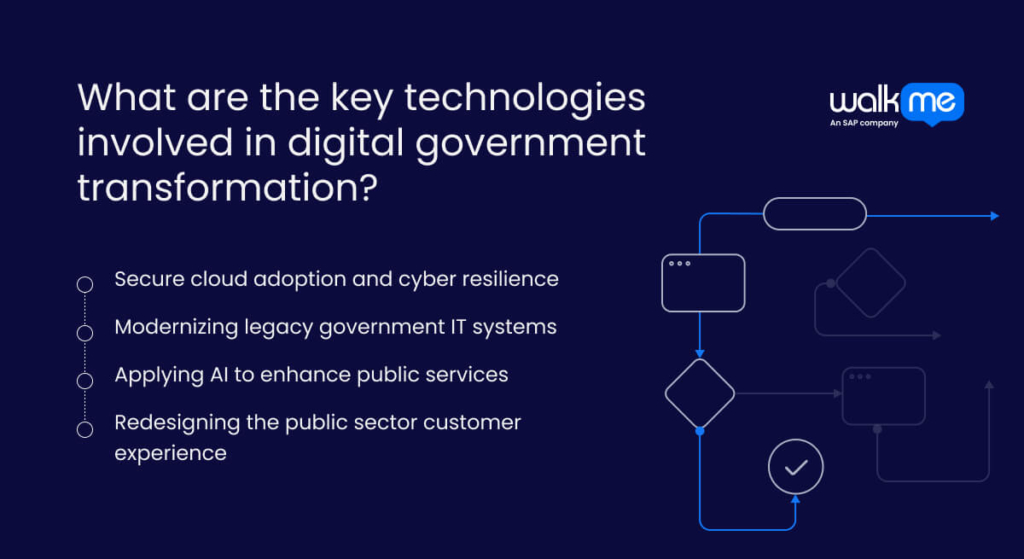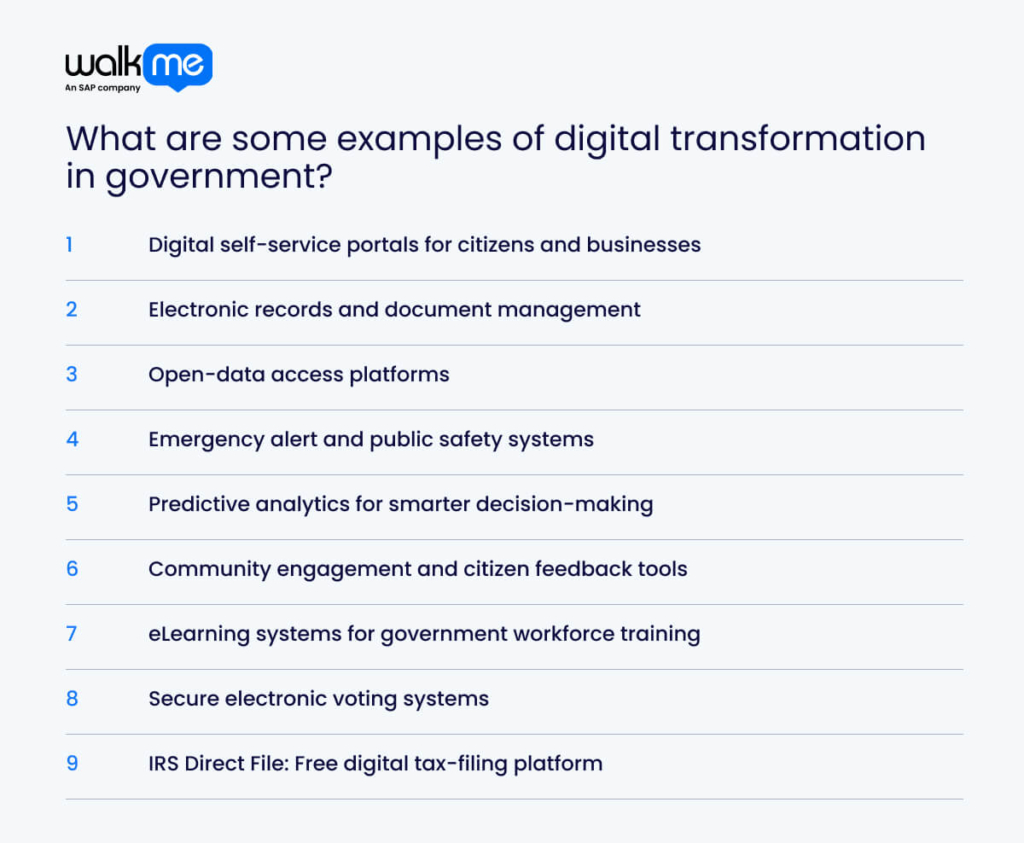Outdated government systems weren’t built for the speed or complexity of the modern world.
Long-standing reliance on paper trails, siloed departments, and outdated infrastructure has made public services slower and less responsive than citizens now expect.
As daily life becomes more digital, including banking, healthcare, and communication, people demand the same efficiency from the government.
Legacy systems are struggling to meet the demands of a digital society, revealing deep gaps in speed, access, and efficiency. Paper-based processes and outdated digital tools slow down services and frustrate citizens who expect more.
Digital transformation is rapidly becoming central to how governments rebuild trustworthy digital experiences, deliver services, and respond to evolving public needs.
This article examines how governments are leveraging technology to modernize services, enhance efficiency, and meet the increasing expectations of citizens in the digital age.
What is digital transformation for government?
Digital transformation in the government focuses on modernizing services through technology to improve efficiency and citizen access.
It involves replacing outdated systems with digital platforms, automating tasks, and applying data-driven tools like AI to deliver faster, more transparent, and user-friendly services.
For example, the Social Security Administration has recently expanded its online services, enabling more applications and inquiries to be processed digitally.
Similarly, the Department of Veterans Affairs launched an AI-powered chatbot to provide veterans with instant support and information. Meanwhile, the General Services Administration invested in cloud-based platforms to streamline procurement and reduce paperwork.
These initiatives demonstrate how U.S. government agencies are adopting digital tools to make their services faster, more transparent, and easier for citizens.
Why is digital transformation for government important?
Digital transformation is essential because citizens expect faster and easier access to government services, such as renewing a driver’s license or applying for benefits online.
For instance, the U.S. Census Bureau used AI cloud transformation to process data faster and more accurately. This significantly reduced processing times and improved data quality, enabling better policy decisions and more efficient allocation of resources across communities.
Without digital change, governments risk wasting taxpayer resources and frustrating citizens with slow progress. Transformation ensures the government keeps pace with technology and public expectations while managing resources wisely.
Who is responsible for digital government transformation?
As with any digital transformation, numerous factors need to be considered.
We’ve developed the table below to help you understand the key players and their roles in making digital government a reality.
| Group | Role in digital transformation | Key responsibilities | Challenges |
| Government leadership | Provides overall direction and accountability for digital initiatives | Set clear goals, secure budgets, champion change, and align transformation with broader government strategy | Balancing innovation with political and budget constraints |
| IT departments & digital teams | Develop, deploy, and maintain the technical systems and infrastructure | Design user-friendly platforms, ensure system reliability, integrate new tech, and manage cybersecurity risks | Keeping pace with rapidly evolving technology and threats |
| Policy makers | Create frameworks and regulations that guide digital efforts | Establish data privacy, security standards, and compliance; enable innovation through flexible policies | Navigating legal complexities and balancing innovation with risk |
| Frontline public services | Apply new technologies and processes in their daily work to improve service delivery | Train staff on new tools, gather user feedback, identify practical barriers, and adapt workflows accordingly | Overcoming resistance to change and ensuring smooth adoption |
| Citizens & stakeholders | Act as end-users and contributors to the design and improvement of services | Provide feedback, participate in consultations, hold the government accountable, and advocate for accessibility | Ensuring inclusive participation and managing diverse needs |
What are the key technologies involved in digital government transformation?

Digital transformation in government depends on several important technologies that help make public services faster, safer, and easier for everyone to use.
Let’s take a closer look:
Secure cloud adoption and cyber resilience
Governments are moving their data and services to online multi-cloud servers that store and manage information. This change lets agencies share data easily and scale services when needed. But protecting citizens’ personal information is also paramount.
Governments use strong security tools like encryption (which scrambles data), multi-factor authentication (extra steps to verify identity), and constant monitoring to maintain data integrity during digital transformations. Digital resilience means they prepare for attacks, detect problems quickly, and recover without losing important information.
Modernizing legacy government IT systems
Many government offices still rely on aging computer systems that are slow and hard to update. Modernizing means replacing these with newer, flexible systems that work in tandem.
For example, moving from paper to digital forms or using software to connect different departments. This makes services more instantaneous and reduces errors. Updating old systems also helps governments save money and support new technologies.
Applying AI to enhance public services
AI helps governments improve how they serve people and can power chatbots so people don’t have to wait on the phone. AI also helps spot problems like fraud or predict when equipment needs fixing.
For example, AI can speed up applications for government housing or provide personalized guidance. It automatically verifies documents, cross-checks applicant information against multiple databases, and flags incomplete or inconsistent data for review.
Redesigning the public sector customer experience
The way people interact with government is changing, and governments are redesigning websites, apps, and kiosks to be easier to use and accessible to everyone, including people with disabilities or those who speak different languages.
They use clear language, simple steps, and offer phone, tablet, and computer services. Some governments create one place where people can access many services with a single account, making it less disjointed.
What are some examples of digital transformation in government?

True digital transformation in government is visible in moments where policy, process, and public need align to create meaningful change.
The most compelling examples reimagine how institutions earn trust, respond with agility, and stay accountable in a digital age.
Let’s take a closer look at some examples of digital transformation in government:
Digital self-service portals for citizens and businesses
These websites let people and companies complete tasks online without visiting offices. You can apply for permits, pay bills, or check status anytime. It saves time and cuts down queues. The portals are designed to be easy to use, often guiding users step-by-step, so everyone can get things done quickly from home or work.
Electronic records and document management
Instead of paper files, governments are storing documents digitally. This makes finding and sharing information faster and more secure. Digital systems reduce the risk of lost papers and help keep records organized. Staff can access files remotely, speeding up responses and reducing delays in service delivery, while protecting sensitive data with strong security measures.
Open-data access platforms
Governments publish datasets online that anyone can access and use. These platforms promote transparency, allowing people to see information like budgets, crime rates, and public health stats. Open data encourages innovation, as developers and researchers can build apps or conduct studies to improve communities. It helps build trust by showing how government decisions are made.
Emergency alert and public safety systems
These systems quickly warn people during crises like storms, fires, or other dangers. Alerts arrive by text, phone calls, or apps, helping people stay safe. Governments use real-time data to update messages and coordinate emergency responses. This technology saves lives by keeping communities informed and prepared for fast action.
Predictive analytics for smarter decision-making
Governments analyze past data to predict future trends, like where traffic jams will form or which areas might need more healthcare resources. This helps plan services better and use budgets wisely. Identifying patterns early means officials can prevent problems before they happen and deliver the right support to the right places at the right time.
Community engagement and citizen feedback tools
Online surveys, apps, and forums let people share opinions and ideas with government officials. These tools make gathering input on policies, projects, or services easier. Listening to citizens helps governments understand needs and improve programs. It builds stronger connections between people and their leaders, ensuring decisions reflect community priorities.
eLearning systems for government workforce training
Governments use online courses to train employees anytime, anywhere. This flexible learning helps staff update skills without interrupting assignments. eLearning covers topics from technology adoption to customer care. It keeps employees prepared for changing demands, improving how government teams serve the public efficiently and effectively.
Secure electronic voting systems
Digital voting platforms enable people to cast ballots online securely. These systems use encryption and verification to protect voter privacy and prevent fraud. Secure e-voting increases accessibility, allowing more citizens to participate, including those with mobility challenges or living abroad. It aims to make elections faster, safer, and more convenient.
IRS Direct File: Free digital tax-filing platform
IRS Direct File lets taxpayers submit federal tax returns online for free. The platform guides users through each step, reducing errors and simplifying complicated forms. It speeds up processing and refunds, especially for those with simple tax situations. This digital tool makes filing taxes more affordable and less stressful for millions of Americans.
What are the benefits of digital transformation in government?
Digital transformation reshapes how government operates, affecting employees, service delivery, and public engagement in many practical ways.
Let’s take a closer look at the benefits of digital transformation in government:
Higher productivity and workplace satisfaction in the public sector
Caseworkers in state agencies can now pull up benefit histories instantly using digital dashboards, instead of sorting through paper files. This saves hours each week and reduces burnout. Staff in unemployment offices or permit departments spend more time helping residents instead of chasing missing paperwork.
Smoother service delivery with fewer administrative mistakes
When someone applies for SNAP benefits online, the system can auto-fill known details and flag missing documents in real-time. This reduces follow-up calls, prevents rejections, and ensures faster approval. The same applies to license renewals or student aid, making the process less frustrating for everyone involved.
Stronger transparency and easier collaboration across departments
Cities like Los Angeles now use shared platforms to track spending on homelessness across agencies. Everyone from housing to healthcare departments can see what’s being done and where gaps exist. Residents can also view this data online, building trust through open reporting on how public funds are used.
What are the challenges of digital transformation in government?
Implementing new digital tools in government brings complex issues that require careful planning, resources, and ongoing management.
Let’s take a closer look at the challenges of digital transformation in government:
Simplifying the hiring process without compromising security or standards
State and local governments need cloud engineers, big data analysts, and cybersecurity staff, but civil service rules often slow hiring. New pilot programs in Colorado and California let agencies test faster screening while still running background checks. The goal is to compete with tech salaries without weakening public hiring standards.
Enabling secure, remote work across government departments
The U.S. Department of Veterans Affairs upgraded IT to let thousands of employees process health claims from home. But smaller cities still struggle to fund secure VPNs and laptops for hybrid teams. Agencies must balance flexibility with cybersecurity, especially when dealing with sensitive medical or financial data.
Automating routine tasks while maintaining oversight for sensitive processes
In New York, AI helps scan housing applications for missing information. But final approvals still go to a case manager. That balance is key: automation handles volume, while humans ensure fairness. Governments must define clear boundaries so that machines assist rather than replace public servants in complex decisions.
How to achieve digital transformation in government
Making government work better with digital tools means changing how things are done and thinking about everyone affected—workers, citizens, and communities.
With that in mind, let’s take a closer look at how to achieve a digital transformation in government:
Secure cloud usage
Moving services and data to the cloud helps governments be faster and more flexible. But keeping personal information safe is important, especially for vulnerable groups. Governments must select trusted cloud providers that adhere to privacy regulations and safeguard data with robust security measures, such as encryption. This helps everyone, from seniors applying for help to small businesses accessing permits and using services without worry.
Adjust procurement and budgeting processes
Buying technology shouldn’t take months or years. Governments require faster and fairer methods to procure software and services that cater to the diverse needs of their communities. This means shorter contracts, testing small projects first, and partnering with local startups or minority-owned businesses. Budgets should also support training and maintenance, ensuring that services continue to improve after launch.
Strengthen collaboration with IT
Digital changes succeed when IT teams and government workers from all departments work together early on. IT teams can help design tools that are easy to use for people with different abilities and backgrounds. Creating teams with diverse voices ensures solutions fit real needs. Training leaders and staff on digital reskilling also helps everyone feel secure and included.
Build support to navigate change
Changing how the government works can feel difficult or confusing. Leaders must explain why changes matter and how they will help staff and the public. Involving frontline workers early means their concerns and ideas shape new systems. Offering training and ongoing support ensures everyone can learn at their own pace. Listening to feedback also helps adjust plans so no one is left behind.
Redefining government through digital transformation
Digital transformation alters how the government delivers services, focusing on simplifying and streamlining processes for citizens. It replaces outdated systems that often cause delays and confusion.
Strong leadership and cooperation across departments enable governments to effectively handle the numerous challenges associated with updating outdated systems. Protecting personal information is also necessary to keep people’s trust in digital services. Equally important is ensuring everyone, whether living in a city or a remote area, has fair access to these new tools.
When done thoughtfully, digital transformation opens government operations to more public oversight. It enables governments to respond more effectively to community needs and fosters stronger connections between officials and citizens.
Over time, these changes lead to a digital government strategy and public services that work better for all, reflecting the real needs of the people they serve.
FAQs
Digital transformation enables governments to share clear, easily accessible information about their activities. People can see where money goes and how decisions happen. This openness helps everyone trust the government more and feel like their voices matter when watching how things are done.
Data privacy refers to the protection of individuals’ personal information when they use online government services. It stops others from misusing that info. When privacy is protected, everyone feels secure using digital tools and trusts the government to safeguard their information properly.
Small or local governments can start with simple, affordable digital tools that fit their community’s needs. They can work with nearby governments to share ideas and resources. Training workers helps everyone use new tools well, making government services accessible.

